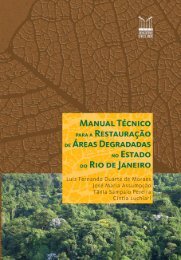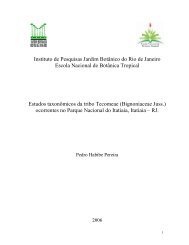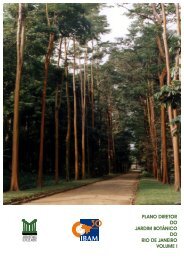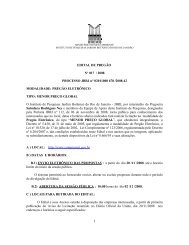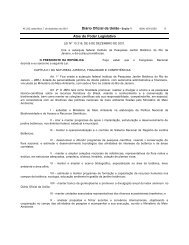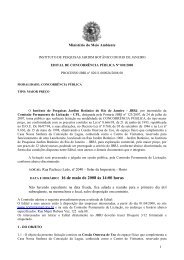anatomia do lenho e dendrocronologia de lianas da famÃlia ...
anatomia do lenho e dendrocronologia de lianas da famÃlia ...
anatomia do lenho e dendrocronologia de lianas da famÃlia ...
Create successful ePaper yourself
Turn your PDF publications into a flip-book with our unique Google optimized e-Paper software.
52<br />
ever present in all samples from each species and in all growth rings from each sample. The<br />
macroscopic observation provi<strong>de</strong>s the distinction by the same features of microscopic<br />
observation; with exception of radially flattened latewood cells that is only possible to <strong>de</strong>tect<br />
in microscopic view. Generally, the macroscopic view facilitates the <strong>de</strong>tection of growth rings<br />
boun<strong>da</strong>ries because of a broad field view.<br />
The features that distinguish the growth ring boun<strong>da</strong>ries observed in this study are frequently<br />
associated to a great number of the tropical tree species (Boninsegna et al. 1989; Détienne,<br />
1989; Worbes, 1989; Heinrich et al., 2006; Marcati et al., 2006), and may be viewed in<br />
several combinations within Leguminosae family, e.g.: marginal parenchyma bands<br />
(Boninsegna et al., 1989; Détienne, 1989; Worbes, 1989; Gourlay, 1995a, 1995b; Eshete &<br />
Stahl, 1999; Roig et al., 2005); radially flattened and thick-walled latewood fibres (Barros &<br />
Calla<strong>do</strong>, 1997; Barros et al., 2001); marginal parenchyma bands and thick-walled fibres in the<br />
latewood (Calla<strong>do</strong> et al., 2001a); marginal parenchyma, radially flattened and thick-walled<br />
latewood fibres (Vetter & Botosso, 1989, Tomazello Filho et al., 2004); marginal parenchyma<br />
bands, and pattern of concurring parenchyma and fibre tissue (fibrous zone) (Worbes, 2002),<br />
change in vessel diameter and marginal parenchyma (Villalba & Boninsegna, 1989; Richter &<br />
Dallwitz, 2000)<br />
Wood anatomy studies related to Leguminosae systematic show that many species present<br />
diffuse porosity and only few species have ring-porous or semi-ring-porous (Wheeler & Baas,<br />
1992; Gasson, 1994, 2000; Höhn, 1999). Some African Caesalpinioi<strong>de</strong>ae and Mimosoi<strong>de</strong>ae<br />
species when grouped by wood anatomy produce eighteen groups all having diffuse porous,<br />
among them, seven show distinct growth rings and have marginal parenchyma (Höhn, 1999).<br />
The occurrence of mainly diffuse porous was not verified in this study, which one half of<br />
species shows diffuse porosity and other half shows semi-ring-porous.<br />
Studies with African Acacia species show that they have growth rings distinguished mainly<br />
by marginal parenchyma, many times represent one year (Gourlay, 1995a, 1995b; Eshete &<br />
Stahl, 1999) and abun<strong>da</strong>nt prismatic crystals of calcium oxalate are related to marginal<br />
parenchyma (Gourlay, 1995a, 1995b). In present study S. tenuifolia and the other three<br />
species with distinct growth rings have abun<strong>da</strong>nt calcium oxalate prismatic crystals related to<br />
marginal parenchyma. The others Senegalia species with growth rings of sporadic occurrence<br />
also show calcium oxalate prismatic crystals related to marginal parenchyma in distinct<br />
boun<strong>da</strong>ries. The Senegalia species in the present study before belonged to Acacia genus.<br />
Recently the New World taxa from Acacia subgenus Aculeiferum Vassal were relocated to<br />
Senegalia genus (Seigler et al., 2006).



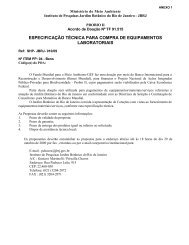
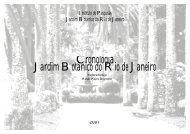
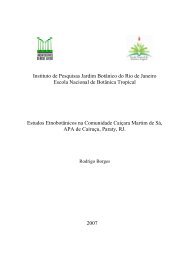
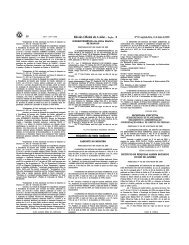
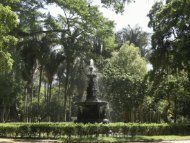
![Memorando nº [Número do memorando/DAMF-RJ/Nome da Unidade]](https://img.yumpu.com/43163661/1/184x260/memorando-na-namero-do-memorando-damf-rj-nome-da-unidade.jpg?quality=85)
